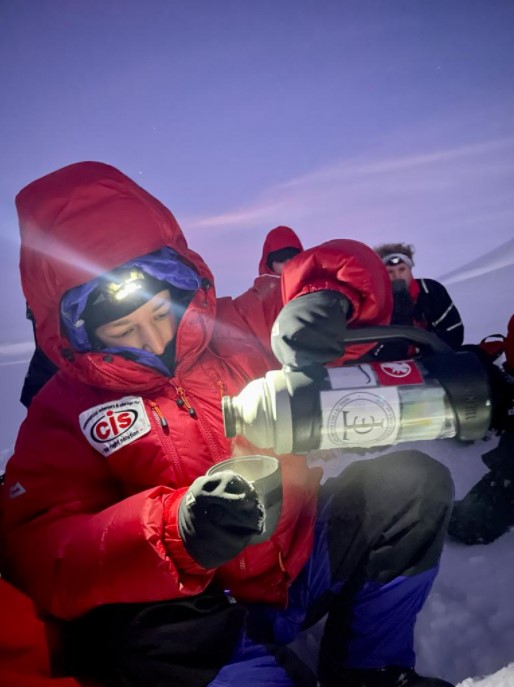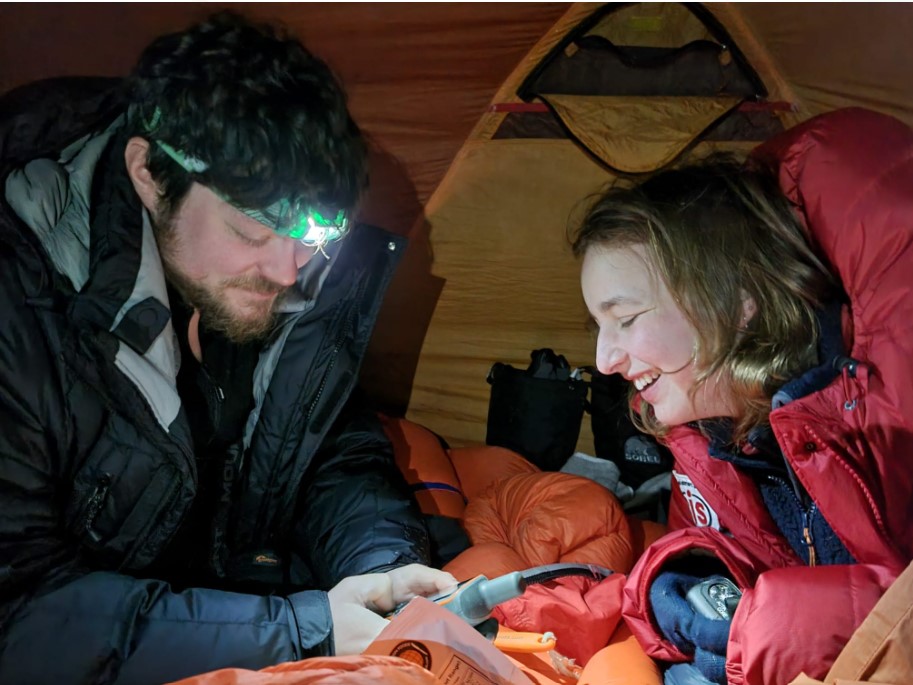Scientific expedition completion update
Following the previous post about the training for the scientific expedition to the Arctic, Sonia, our ‘sponsee’, has provided us with an update on the completion of the expedition:
After two weeks of preparations in the Arctic, the team set off on the 8-day scientific expedition across the valleys of Svalbard. Anticipation, excitement, and nerves were all high as the team packed final bits into the pulks, adjusted the harness straps, and strapped boots into the ski bindings.
And then we were off.
Skiing out of the town of Longyearbyen (where we had spent the last two weeks) and leaving the lights behind felt good. And thoughts of the week ahead flooded the mind. Would we achieve all our aims? What conditions would we face? And would we all make it?
We would then set off skiing: 2 hours on, 15 minutes off, 2 hours on – until we reached our camp for the night. We aimed to keep our breaks to 15 minutes – in which time we would stuff as much food and liquid into us as quickly as we could, however its length was often determined by how long we could keep warm without moving, often closer to 8 minutes.
We would repeat this until we reached our camp for the night. Here it would be the routine of setting up camp, taking scientific measurements, and boiling snow water to rehydrate meals and fill flasks before settling in to get some much-needed sleep. A similar routine was set for mornings.
The expedition got off to a tough start, and on day 1 two strong team members had to be extracted due to old injuries resurfacing. It was a strong reminder that what we were doing was tough and that we should be prepared to expect anything.
Our route took us into Polar Bear territory, which meant we would have people on the lookout at all times. During the day we would all keep an eye out whilst skiing, and at night polar bear watch would become a rota, and we were each assigned around 2hrs 30min a night each to keep watch.
My polar bear watches made up both my favorite and least favorite portions of the entire experience. Once woken, I would extract myself from my warm sleeping bag and as quietly as possible, so as to not wake my sleeping teammates, would dress into warm down outer clothing and attempt to exit the tent without stepping on anyone in the dark. Here I would meet the previous bear watcher and would exchange information on the surroundings, before being passed a flare gun, pen flares, the rota and a watch – before they would head off for some sleep.
After taking a good look around, I would often start my bear watch with some hot water from my flask. I would then take my first set of scientific measurements – which I would continue until my hands got too cold, after which I would stick my hand in my armpit to warm up before putting my outer layer of gloves back on. Then I’d start doing my daily stretches which had the duel benefit of keeping me moving and warm whilst outside, and preventing injuries from skiing. Whilst continuously keeping a look out I’d spend my watches rotating between hot drinks, taking measurements and doing stretches. Bear watch often went quite quickly and when conditions were good it felt great to spend some time just me and nature, it felt very calming and fairly incredible when the aurora was strong. Bear watch alone and in a storm when temperatures were in the -20s, however, felt less calming, and the complete lack of visibility was slightly unnerving at times.
There were no polar bear sightings during this expedition.
Reaching the waterfall marked our halfway point! I don’t know why I was surprised it was frozen. It was a great moment for the team to celebrate by getting a group photo together!
Throughout the week we experienced drastic temperature fluctuations, completely calm days, extremely windy days, whiteouts, and a mix of precipitation levels. There was one afternoon when the side wind was so strong our pulks would get caught by the wind and attempt to drag us sideways, and a few of us fell over in the strongest gusts. Our coldest recorded temperature was -25°C and our warmest was around 0°C. Other days were calm and the sky was filled with stars, satellites and on occasion, the aurora would come out for us. The weather did fluctuate far more greatly than expected – something which is becoming more frequent as predicted by science due to increasing green-house gases in our atmosphere and resultant climate change.
This reinforced the very reason we were here – to accurately measure on-the-ground weather data, enabling the calibration of the weather station models. The weather data collected during this expedition will be analysed and sent to the Met Office to use for calibration of models. This included Barometric Pressure, Density Altitude, Dew Point Temperature, Heat Stress Index, Relative Humidity, Station Pressure (Absolute Pressure), Temperature, Wet Bulb Temperature (Psychrometric) and Wind speed. We will also inform the Norwegian Polar institute that there were no polar bear sightings on our route – this will contribute towards their ongoing studies of polar bear distribution.
It was overall a testing week with a real sense of achievement upon completion. There were many learnings across the week (for me, appreciating the practical difficulties of collecting simple sets of data in extreme environments was a big one), and the team are all looking forward to the next big scientific expedition.
A massive thank you to CIS who have supported me on this expedition, it really has helped make it all possible!
It has been a pleasure to sponsor Sonia’s journey for such an important cause. We hope the data gathered during this expedition help fuel future decisions about how climate change is having an impact across the world.






